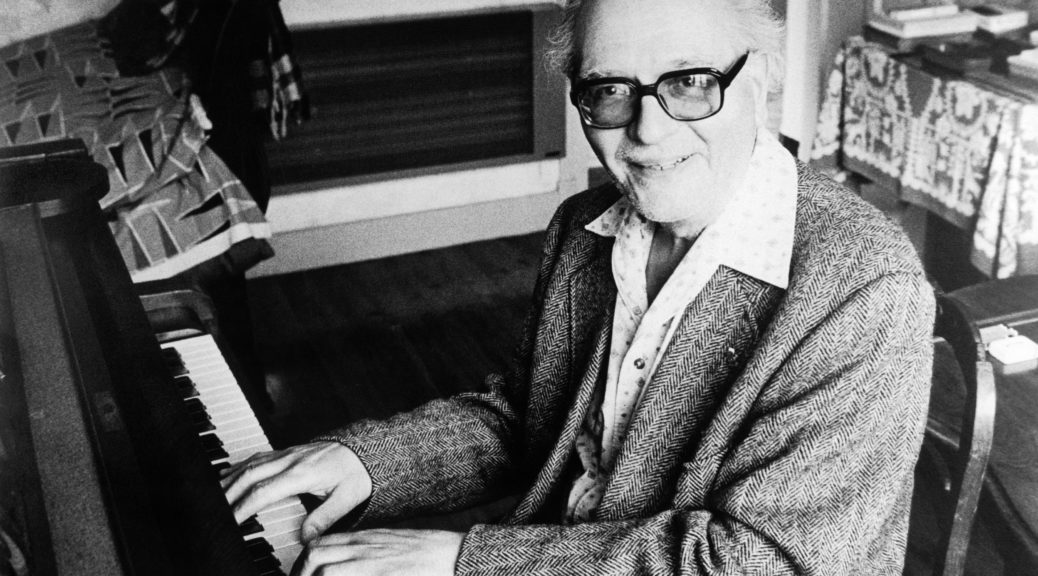
KALEIDOSCOPIC MUSICAL EXPERIENCE
OAKLAND—It was a bizarre concert, the most haphazard of events thrown like a tossed salad, yet one of the most stimulating of the season. Single-sheet printed programs were late arriving (ink already dry!), handed out to patrons moments before the downbeat. And no one thought to print the names of the three instrumentalists anywhere.
You hardly expected a barn-burner, in a modest 150-seat church well removed from the main venues, with the long-haired presenter/arranger/pianist Derek Sup buzzing about in his black T-shirt attending to all the last-minute staging touches, then casually littering the floor with his score pages one by one as he finished playing them.
The all-French 20th-century program focused on Olivier Messiaen (1908-1992) under the rubric “Messiaen and Beyond,” including either composers who influenced him, or vice versa. Included was almost everything short of the kitchen sink: Two videos of the composer, solo piano, piano trio, duet, myriad arrangements and transcriptions, a cappella choir, even pipe organ.
By their audaciously mixing various concert genres, the trio provided a throwback to pre-1900 when mixed genres were common in concerts (with orchestra sometimes inserted here and there). Common, too, were the free arrangements of the music for scaled-down combinations, unlike today’s more rigorous, composer-is-king practice. I found myself nervously groping for some seat belt, trying to prepare for each new adventure unreeling before us.
We got a rapid array of wildly dissimilar bed-fellows: composers Debussy, Ravel, then the younger radicals Xenakis and Ligeti, including a Greek title not even the performers could translate, Dhipli zyia (meaning, more or less, ‘double symmetry’). This meant hoedown-like Xenakis, vs. soulful and aphoristic Ligeti.
And between, pieces by Messiaen, an expert birder who married a woman whose name was pronounced the same as the golden oriole: Loriod/Loriot. Messiaen threw long-studied rapid bird chirps into solo piano pieces with varying success.
More striking yet was his intense case of synesthesia, where each note or chord produced internal images of vivid colors. This trait was one shared with composers like Scriabin, Sibelius and Ligeti. More interesting to me than his highly dissonant chords are his vivid descriptions of the “light show” that the colors produced in him.
The third notable Messiaen characteristic is his intensely religious bent. This emerges in his early and best-known work, “Quartet for the End of Time,” written in a World War Two prison camp.
Sup, who is also music and choir director at St. Paul Lutheran, played piano and organ, joined in chamber music with cellist Lewis Patzner and violinist Corey Mike. In notable digressions he led the virtuosic 13-member church choir in Messiaen’s rather tricky a cappella motet, “O Sacrum Convivium,” then raised the roof with the jangling, effusive organ piece played by memory, “Dieu parmi nous” (God Amongst Us). The latter surely projected every conceivable bright color combination whenever the composer himself played it back in Paris. Oh how we wished for a sudden epidemic of synesthesia to sweep the whole audience off their feet in a multi-media way!
MUSIC NOTES—Messiaen himself journeyed to Oakland in the early 1980s as composer-in-residence at the Berkeley Symphony… St.Paul Lutheran is a compact edifice built by Swedish immigrants in 1887—one of Oakland’s oldest churches.
“Messiaen and Beyond” concert at St. Paul Lutheran Church, Oakland, CA April 27. For info: (510) 530-6333, or go online.